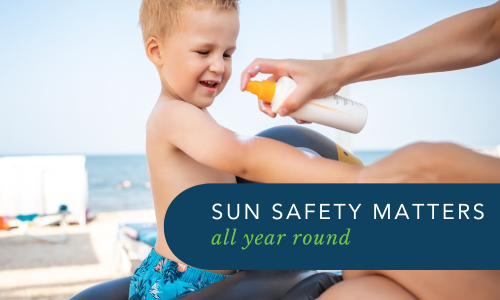Around the world, we are known for our beautiful beaches, outdoor lifestyle, and long sunny days. However, we are also known for having some of the highest levels of ultraviolet (UV) radiation in the world. With a high rate of skin cancer and daily exposure to harsh sun conditions, sun safety in Australia is not just a seasonal habit—it’s a year-round necessity.
Understanding how to protect your skin from harmful UV rays, regardless of the weather or time of year, is vital for your long-term health. This is even more important if your work involves spending many hours outdoors. Sun protection is essential in Australia and here’s how you can keep your skin safe all year round.
Why UV Protection Matters in Australia
Australia’s location close to the equator, clear skies, and relatively low levels of atmospheric pollution contribute to consistently high UV levels. In fact, UV radiation in Australia can be dangerous even on cool, cloudy, or windy days.
According to the Cancer Council, around two in three Australians will be diagnosed with skin cancer by the age of 70, making it the most common cancer in the country. This alarming statistic is largely driven by overexposure to UV radiation.
Importantly, UV levels are not related to temperature. This means you can get sunburnt on a cold day, particularly if you’re outdoors for long periods without protection.
What Are UV Rays?
UV (ultraviolet) radiation is a form of energy emitted by the sun. There are three types:
- UVA: Penetrates deeply into the skin and contributes to ageing and long-term skin damage.
- UVB: Causes sunburn and plays a key role in the development of skin cancer.
- UVC: Absorbed by the atmosphere and does not reach the Earth’s surface.
Both UVA and UVB rays can damage the DNA in skin cells, potentially leading to melanoma and other skin cancers. In Australia, with its high UV index, daily protection is essential, regardless of age or skin tone.
The UV Index: Know When You Need Protection
Australia uses the UV Index, a standard measure of UV radiation levels. The scale goes from 0 (low) to 11+ (extreme). When the UV index is 3 or above, sun protection is recommended.
In many parts of Australia, the UV index reaches 3 or higher for most of the year—even in winter. The Cancer Council’s free SunSmart app is an excellent tool that provides daily UV alerts and reminders for sunscreen application.
Myth-Busting: Common Misconceptions in Australia
“I only need sunscreen in summer.”
Truth: UV radiation is present year-round. In places like Brisbane or Darwin, the UV index can exceed 3 nearly every day of the year.
“I can’t get sunburnt on a cloudy or windy day.”
Truth: Up to 80% of UV rays penetrate clouds. Windy days can make the skin feel cool, masking the signs of burning.
“I have dark skin, so I don’t need sun protection.”
Truth: While darker skin has more melanin and offers some protection, it does not prevent skin cancer or other UV-related damage.
Year-Round Sun Safety Strategies
- Slip on Protective Clothing
Wear long-sleeved shirts, pants, or skirts made from tightly woven fabric. In Australia, many outdoor clothing brands offer gear with built-in UPF (Ultraviolet Protection Factor) ratings. If you supply your own clothing, look for these built in protective features. Clothing supplied by your employer needs to meet these standards.
- Slop on SPF 30+ Sunscreen
Choose a broad-spectrum, water-resistant sunscreen with at least SPF 30. Apply it 20 minutes before heading outside and reapply every two hours—or more often if sweating.
Sunscreen should be used every day, especially when UV levels are 3 or higher. It’s also important to apply enough: for an adult, about a teaspoon per limb, and one for the face, neck, and ears.
- Slap on a Hat
A broad-brimmed hat protects the face, neck, and ears—areas most commonly affected by skin cancer. Avoid baseball caps and visors that leave the neck and ears exposed.
- Seek Shade
Where possible, stay in the shade—especially during peak UV hours between 10 am and 4 pm. Trees, buildings, or portable shade structures like beach umbrellas are all helpful.
- Slide on Sunglasses
Protect your eyes from UV damage with sunglasses that meet Australian Standard AS/NZS 1067. Look for labels that indicate “UV400” or “100% UV protection.”
Sun Safety by Season in Australia
🌸 Spring
UV levels begin to rise quickly, catching many people off guard after winter. It’s a high-risk time for accidental sunburn, especially during outdoor activities like gardening or sports.
☀️ Summer
This is the most dangerous season in terms of UV exposure. In many regions, the UV index frequently exceeds 11, considered “extreme.” Take extra care when working outdoors- clothing, hats & reapplying sunscreen.
🍂 Autumn
As the weather cools, many Australians reduce their sun protection. However, UV levels can still remain high, particularly in the northern parts of the country.
❄️ Winter
In southern Australia, UV levels drop in winter, but they often remain above 3 in the northern states. Snow can reflect up to 80% of UV rays, increasing the risk of sunburn.
The Role of Vitamin D
Vitamin D is important for bone health and is produced in the skin in response to sunlight. However, in Australia, most people can maintain adequate vitamin D levels with just a few minutes of incidental sun exposure on the face, arms, and hands on most days.
Prolonged sun exposure is not required and increases skin cancer risk. If you’re concerned about vitamin D levels—especially in winter or if you have darker skin—consult your GP for a blood test and advice.
Regular Skin Checks and Early Detection
Even with excellent sun protection, it’s important to be vigilant. Early detection of skin cancer significantly improves outcomes. You should:
- Perform monthly self-checks, looking for new spots or changes in existing moles.
- Watch for asymmetry, uneven borders, changes in colour, diameter, or evolving spots (the ABCDE rule).
- Visit a dermatologist or skin cancer clinic annually, especially if you have a personal or family history of skin cancer.
Sun Protection for Children
Australian children are exposed to high UV levels from a young age, and excessive sun exposure during childhood greatly increases the risk of skin cancer later in life. To protect them:
- Use child-friendly sunscreen daily.
- Dress them in protective clothing and hats.
- Encourage play in shaded areas.
- Educate them on sun safety habits from a young age.
Schools and early learning centres across Australia often implement “No Hat, No Play” policies, which help reinforce sun safety.
With awareness, daily protection, and proactive habits, you can enjoy the outdoors safely whether it be for work or for play.
Sun safety is not just for summer—it’s a lifelong commitment. By following the SunSmart principles of “Slip, Slop, Slap, Seek, Slide,” staying informed about UV levels, and having regular skin checks, you can reduce your risk of skin cancer and keep their skin healthy and protected all year round.
GET IN TOUCH
Are you ready for peace of mind that your workforce is as safe and prepared as possible?
With a dedicated team of staff ready to help you meet compliance requirements and improve the overall safety of your workplace, all you need to do is get in touch.
Request your free audit today!



